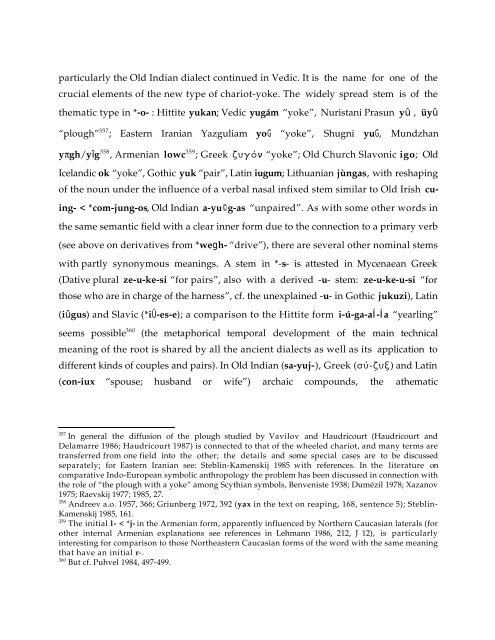Comparative Notes on Hurro-Urartian, Northern Caucasian
Comparative Notes on Hurro-Urartian, Northern Caucasian
Comparative Notes on Hurro-Urartian, Northern Caucasian
You also want an ePaper? Increase the reach of your titles
YUMPU automatically turns print PDFs into web optimized ePapers that Google loves.
particularly the Old Indian dialect c<strong>on</strong>tinued in Vedic. It is the name for <strong>on</strong>e of the<br />
crucial elements of the new type of chariot-yoke. The widely spread stem is of the<br />
thematic type in *-o- : Hittite yukan; Vedic yugám “yoke”, Nuristani Prasun yû , üyû<br />
“plough” 357 ; Eastern Iranian Yazguliam yoG “yoke”, Shugni yuG, Mundzhan<br />
yπgh/yîg 358 , Armenian lowc 359 ; Greek zugÒn “yoke”; Old Church Slav<strong>on</strong>ic igo; Old<br />
Icelandic ok “yoke”, Gothic yuk “pair”, Latin iugum; Lithuanian jùngas, with reshaping<br />
of the noun under the influence of a verbal nasal infixed stem similar to Old Irish cu-<br />
ing- < *com-jung-os, Old Indian a-yu©g-as “unpaired”. As with some other words in<br />
the same semantic field with a clear inner form due to the c<strong>on</strong>necti<strong>on</strong> to a primary verb<br />
(see above <strong>on</strong> derivatives from *we´gh- “drive”), there are several other nominal stems<br />
with partly syn<strong>on</strong>ymous meanings. A stem in *-s- is attested in Mycenaean Greek<br />
(Dative plural ze-u-ke-si “for pairs”, also with a derived -u- stem: ze-u-ke-u-si “for<br />
those who are in charge of the harness”, cf. the unexplained -u- in Gothic jukuzi), Latin<br />
(iûgus) and Slavic (*iÛ-es-e); a comparis<strong>on</strong> to the Hittite form i-ú-ga-aÍ-Ía “yearling”<br />
seems possible 360 (the metaphorical temporal development of the main technical<br />
meaning of the root is shared by all the ancient dialects as well as its applicati<strong>on</strong> to<br />
different kinds of couples and pairs). In Old Indian (sa-yuj-), Greek (sÊ-zuj) and Latin<br />
(c<strong>on</strong>-iux “spouse; husband or wife”) archaic compounds, the athematic<br />
357 In general the diffusi<strong>on</strong> of the plough studied by Vavilov and Haudricourt (Haudricourt and<br />
Delamarre 1986; Haudricourt 1987) is c<strong>on</strong>nected to that of the wheeled chariot, and many terms are<br />
transferred from <strong>on</strong>e field into the other; the details and some special cases are to be discussed<br />
separately; for Eastern Iranian see: Steblin-Kamenskij 1985 with references. In the literature <strong>on</strong><br />
comparative Indo-European symbolic anthropology the problem has been discussed in c<strong>on</strong>necti<strong>on</strong> with<br />
the role of “the plough with a yoke” am<strong>on</strong>g Scythian symbols, Benveniste 1938; Dumézil 1978; Xazanov<br />
1975; Raevskij 1977; 1985, 27.<br />
358 Andreev a.o. 1957, 366; Griunberg 1972, 392 (yax in the text <strong>on</strong> reaping, 168, sentence 5); Steblin-<br />
Kamenskij 1985, 161.<br />
359 The initial l- < *j- in the Armenian form, apparently influenced by <strong>Northern</strong> <strong>Caucasian</strong> laterals (for<br />
other internal Armenian explanati<strong>on</strong>s see references in Lehmann 1986, 212, J 12), is particularly<br />
interesting for comparis<strong>on</strong> to those Northeastern <strong>Caucasian</strong> forms of the word with the same meaning<br />
that have an initial r-.<br />
360 But cf. Puhvel 1984, 497-499.





